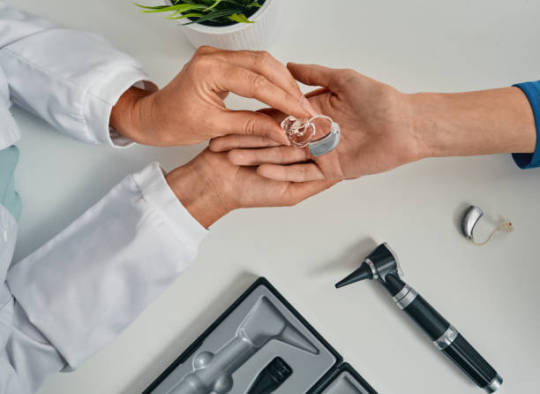Don't wanna be here? Send us removal request.
Text
Hearing Aids: Understanding the Different Styles and Their Benefits
Hearing Aids play a vital role in improving the quality of life for individuals with hearing loss. These small yet powerful devices amplify sound, making it easier to engage in conversations, enjoy music, and participate in daily activities. Understanding the different hearing aid styles can help individuals choose the most suitable option for their needs.

Types of Hearing Aids
There are several styles of hearing aids, each offering unique features and benefits:
Behind-the-Ear (BTE) BTE hearing aids rest comfortably behind the ear and connect to an earpiece through a thin tube. Known for their durability and power, BTEs are suitable for mild to profound hearing loss. They are often preferred for their ease of handling and maintenance.
In-the-Ear (ITE) ITE hearing aids fit inside the outer ear, making them less visible than BTE models. They are custom-molded for comfort and are ideal for individuals with mild to severe hearing loss.
Completely-in-Canal (CIC) CIC devices are nearly invisible, as they sit deep inside the ear canal. While they offer cosmetic appeal, they are best suited for mild to moderate hearing loss.
Receiver-in-Canal (RIC) RIC hearing aids are similar to BTE styles but with a receiver positioned inside the ear canal. This design offers a more natural sound experience and is effective for mild to moderate hearing loss.
Choosing the Right Hearing Aid
When selecting a hearing aid, factors such as the degree of hearing loss, lifestyle, and personal preferences should be considered. An audiologist can help assess individual needs and recommend the most suitable hearing aid style.
Maintaining Hearing Aids
Proper maintenance is essential to ensure the longevity and effectiveness of hearing aids. Regular cleaning, battery checks, and professional servicing help keep the devices functioning optimally.
Conclusion
Hearing aids come in various styles, each offering distinct advantages. Whether you need a discreet in-canal model or a powerful behind-the-ear device, understanding the differences can help you make an informed choice. If you or a loved one is experiencing hearing loss, consulting with a qualified audiologist is the first step toward better hearing and improved quality of life.
0 notes
Text
Hearing Aids: How They Work and Choosing the Right One
Hearing aids are essential devices that help individuals with hearing loss regain their ability to communicate and engage with the world around them. With various hearing aid styles available, understanding how they work and what to consider when choosing one can make a significant difference in improving hearing health.

How Hearing Aids Work
A hearing aid is a small electronic device that amplifies sound, making it easier for individuals with hearing loss to hear and understand speech. It consists of three main components:
Microphone: Captures sound from the environment.
Amplifier: Increases the volume of the sound and processes it to improve clarity.
Speaker: Delivers the enhanced sound into the ear.
Modern hearing aids are equipped with advanced technology, such as background noise reduction, directional microphones, and Bluetooth connectivity, to enhance the listening experience.
Different Hearing Aid Styles
There are several hearing aid styles designed to meet different needs and preferences. The most common types include:
Behind-the-Ear (BTE) Hearing Aids – These rest behind the ear and are connected to an earpiece. They are powerful and suitable for various levels of hearing loss.
In-the-Ear (ITE) Hearing Aids – Custom-molded to fit within the outer ear, these provide a balance of discretion and functionality.
Receiver-in-Canal (RIC) Hearing Aids – Smaller and more comfortable than BTE models, these offer natural sound quality.
Completely-in-Canal (CIC) and Invisible-in-Canal (IIC) Hearing Aids – These tiny devices fit inside the ear canal, making them nearly invisible while offering excellent sound quality.
Factors to Consider When Choosing a Hearing Aid
When selecting a hearing aid, consider:
Degree of Hearing Loss: A professional assessment will determine the best options for your needs.
Comfort and Fit: Choosing the right style ensures a comfortable wearing experience.
Technology Features: Some hearing aids include Bluetooth connectivity, rechargeable batteries, and noise reduction.
Lifestyle Needs: Consider where and how often you will use the hearing aid, such as in social gatherings or quiet environments.
Importance of Professional Hearing Assessments
Before choosing a hearing aid, consulting an audiologist is crucial. A professional assessment helps determine the severity of hearing loss and the most suitable hearing aid styles. Audiologists also provide guidance on maintenance and adjustments for optimal performance.
Conclusion
Hearing aids are life-changing devices that help individuals reconnect with their surroundings. Understanding different hearing aid styles and seeking professional guidance ensures you find the best fit for your needs. If you are experiencing hearing difficulties, scheduling a hearing assessment is the first step toward better hearing health.
1 note
·
View note